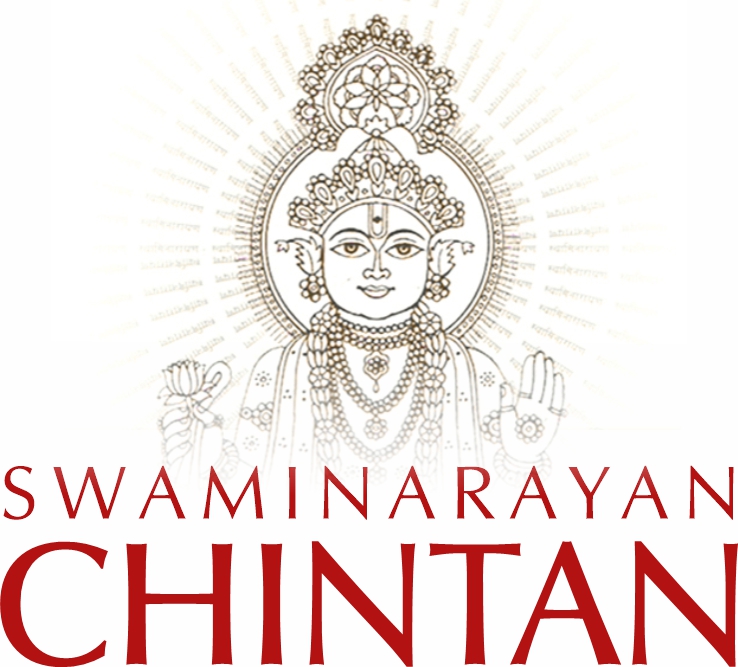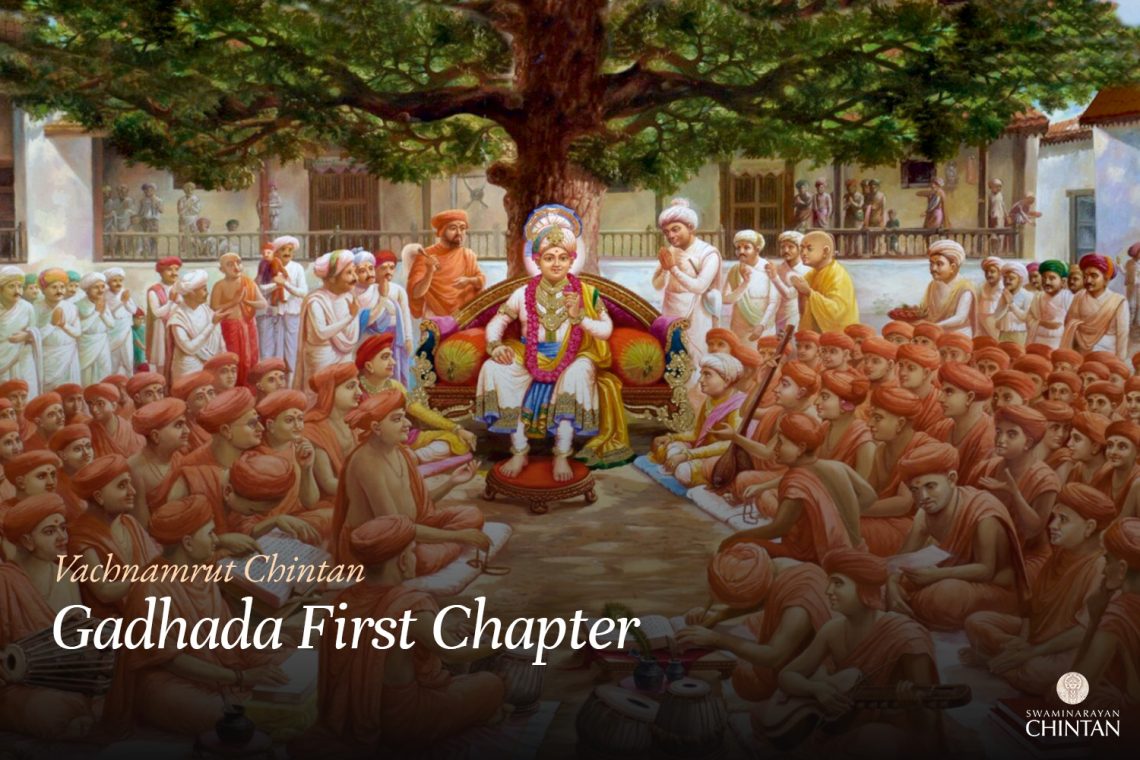Central Insights: Key Points: Explanation In this Vachanamrut, Maharaj gracefully said that a devotee of Bhagavan daily after worshipping, and praising should seek that, ‘O Maharaj! please protect me from kusangi.’ There are four types of Kusangi. First one is Kudapanthi, second Shushkvedanti, third Shaktipanthi, fourth Nastik. In the path of…
Browsing CategoryVachanamrut Chintan
GF-49 Means to fix mind on God.
Central Insights: Key Points: Explanation In this Vachanamrut, Sadguru Brahmanand Swami asks a question: “It requires immense effort to keep our vrutti (focused consciousness) on Bhagwan, while it effortlessly remains engaged in worldly objects. Why is this so?” In response, Shreeji Maharaj explains that for those who are true devotees…
GF-50 Who can be called persons of sharp intelligence?
Central Insights: Key Points: Explanation This Vachanāmrut is about the sharp intellect. Shreeji Māharāj says that one who has a sharp intellect, attains the Brahma (Bhagavan). दृश्यते त्वग्रया बुद्धया सूक्ष्मया सूक्ष्मदर्शिभिः dṛśyate tv agrayā buddhayā sūkṣmayā sūkṣmadarśibhiḥ(Kaṭhopaniṣad 1.3.11) it is said in kathopanishad. Do those who know a lot about…
GF-51 Only a Diamond Can Cut a Diamond
Central Insights: Key Points: Explanation In this Vachanamrut, Purnanand swami asked a question : ten senses are of rajas nature (of Maya), four consciences are of sattva nature (of Maya). Therefore, all senses and consciences belong to Maya, and bhagavan is beyond it. Then how come the determination of bhagavan…
GF-52 Knowing Bhagwan by Four Scriptures
Central Insights: Key Points: Explanation The katha of Moksha Dharma was being read in the courtyard of Dãdã Khãchar, arranged by Shreeji Maharaj. In the katha, one topic came up that if one understands the form of bhagwan by four scriptures Sankhya, Yog, Vedant and Panchratra, then he is considered…
GF-54 Nourishing Bhagwat Dharma; The Gateway to Moksh
Central Insights: Key Points: Explanation This Vachanāmrut is about nourishing Bhagwat Dharma and opening the doors to salvation (Mōkṣha). In this Vachanāmrut, Muktanand Swami asks: “How is Bhagwat Dharma nourished, as mentioned in the 11th canto of the Shrimad Bhagwat in the discourse between King Janak and the nine Yogeshwars,…
GF-56 Hollow Stone
Central Insights: Key Points: Explanation In this Vachanāmrut, Shreeji Māharāj asked the following question: “Shri Krishna bhagwan describes four kinds of devotees in the Gita and identifies a Gyāni devotee to be the best. Each devotee has equal determination of bhagwan. Then how come a gyani devotee is special?” Santos…
GF-57 The Extraordinary cause of salvation
Central Insights: Key Points: Explanation In this Vachanāmrut, Shreeji Māharāj encourages to ask questions. Then, Muktanand Swami asked: “What is the means to attain extraordinary salvation?” Shreeji Māharāj responds: “The knowledge of the divine form and glory of bhagwan are the two means to salvation. Here, what is salvation? That…
GF-58 The Body, Kusang and Past Sanskars; One Becomes like One Perceives the Great
Central Insights: Key Points: Explanation In this Vachanamrut, by the inspiration of Maharaj, Muktanand swami asked a question: O Maharaj! When a devotee of Bhagwan engages in remembrance of Bhagwan, how can the forces of nature (Three modes of nature-Maya: Sattva, Rajas, Tamas) can be overcome in his heart? Thereafter…
GF-59 Extraordinary love
Central Insights: Key Points: Explanation In this Vachanamrut, Muktānand Swāmi posed a question: “O Maharaj! What is the reason behind developing extraordinary love for God?” In response, Shreeji Maharaj stated: “One reason is having faith in the personality of Paramātmā, believing firmly that He is indeed God, along with theism…
GF-60 Achieving Ekantik Dharma; Eradicating Worldly Desires
Central Insights: Key Points: Explanation This Vachanamrut focuses on the importance of avoiding vāsanās (desires). Shriji Maharaj starts with a gracious statement, emphasizing that avoiding vāsanās is a major means to spiritual growth. Living a life free from desires is the hallmark of an ekāntik devotee. Even if a person…
GF-61 The King Bali
Central Insights: Key Points: Explanation In this Vachanamrut, Muktanand Swami first asked, “What is the method for maintaining patience when faced with kām (lust), krodh (anger), lobh (greed), and bhay (fear)?” In response, Maharaj said, “When ātmanishṭhā (self-realization) becomes extremely firm, patience will not waver.” Then, Brahmanand Swami inquired, “How…
GF-62 Acquiring The Qualities Of Bhagwan
Central Insights: Key Points: Even with a conviction in God, if a devotee lacks the right attitude and mistreats true devotees, virtues will not manifest. Instead, demonic qualities will arise. Explanation In this Vachanamrut, Swami Svayamprakashanand poses a question about how the virtues of Satya and Shaucha, which are eternally…
GF-63 Nishchay; Knowing God Perfectly through philosophical view
Central Insights: Key Points: Explanation In this Vachanamrut, Swami Nrusinhanand asks, “What kind of thoughts arise in those who lack conviction (nischay) in God?” Then, Paramchaitanyanand Swami inquires, “What kind of state is experienced by those who have complete conviction?” Finally, Shriji Maharaj also describes the characteristics of one with…
GF-64 The Relationship between Sharir and Shariri; A Master-Servant Relationship
Central Insights: Key Points: Explanation In this Vachanamrut, Shriji Maharaj specifically discusses the relationship between God, the jīva (soul), and the world, describing it as a sharir-shariri relationship. God is the shariri (soul), and the jīva and the world are His sharir (body). Maharaj raises an internal question: there must…
GF-65 Gyan-shakti’, ‘Kriya-shakti’ and ‘Ichchha-shakti’
Central Insights: Key Points: Explanation In this discourse, the question posed is about the process of creation and dissolution of space. Maharaj explains the method and clarifies that physical space and the all-encompassing chidākāśa are different. Only physical space undergoes creation and dissolution; chidākāśa is eternal and does not undergo…
GF-66 Misinterpreting the Words of the Scriptures; The Four Emanations of God
Central Insights: Key Points: Explanation In this Vachanamrut, Shriji Maharaj uses the example of the Bhagvat to discuss the terminology used in scriptures. Scriptures sometimes describe God as having form (Sagun), and at other times as formless (Nirgun). This can lead the reader to mistakenly perceive God as being material…
GF-67 Acquiring the Virtues of the Satpurush
Central Insights: Key Points: Virtues of a satpurush (true saint) are manifested in a seeker only when the seeker maintains divine intellect towards the satpurush and feels remorse for his own flaws and insignificance. Explanation In this Vachanamrut, Maharaj asks the saints if there are any such true saints who…
GF-68 God Forever Resides in the Eight Types of Murtis and in the Sant
Central Insights: Key Points: Explanation In this Vachanāmrut, Shreeji Māharāj says: “In Samvat 1869 whenever I entered Samādhi, it seemed as though I traveled to Purushottam-puri and resided within the idol of Jagannathji. Through the eyes of that idol, I saw everyone, including the devotion and deceit of the priest.…
GF-69 The Dharma of a Wicked Person and a Sadhu
Central Insights: Key Points: Explanation In this Vachanamrut, Shriji Maharaj posed a question: What is the definition of dharma? Provide an answer according to the scriptures. Even the violent kings who came for refuge would neither kill a living being nor allow others to kill. Thus, those who sought refuge…
GF-70 Kakabhai’s Question; A Thief Injured by a Thorn
Central Insights: Key Points: Explanation Here Kakabhai from Rojka asks Nityanand Swāmi: “There is a voice within us that tells us to indulge in worldly desires and another that says to stay away from it. Who are these two?” Thereupon Nityanand Swāmi Answers: “The voice saying No is the soul…

